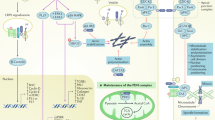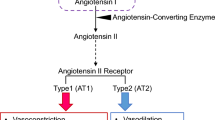Abstract
The (pro)renin receptor, PRR, was initially characterized as a component of the renin-angiotensin system (RAS). PRR-bound renin and prorenin display increased enzymatic activity, and binding activates intracellular signaling, upregulating the expression of profibrotic proteins. As a consequence, most studies set out to demonstrate a role of PRR in hypertension, cardiovascular and renal diseases, and organ damage, and to identify PRR as a therapeutic target to optimize RAS blockade. The results of animal studies were disappointing and did not convincingly establish PRR as major player in hypertension or in organ damage, although human studies suggested a link between a polymorphism in the PRR gene and blood pressure. New data now suggest that PRR is functionally linked to the vacuolar proton-ATPase and, quite unexpectedly, that PRR is necessary to Wnt signaling pathways that are essential (independently of renin) for adult and embryonic stem cell biology, embryonic development, and diseases including cancer, thereby opening new perspectives on the pathophysiological roles of PRR.


Similar content being viewed by others
References
Papers of particular interest, published recently, have been highlighted as: • Of importance •• Of major importance
Nguyen G, Delarue F, Burcklé C, et al. Pivotal role of the renin/prorenin receptor in angiotensin II production and cellular responses to renin. J Clin Invest 2002, 109: 1417-1427.
Nabi AHMN, Kageshima A, Uddin MN, et al. Binding properties of rat prorenin and renin to the recombinant rat renin/prorenin receptor prepared by a baculovirus expression system. Int J Mol Med 2006, 18: 483-488.
Huang Y, Wongamorntham S, Kasting J, et al. Renin increases mesangial cell transforming growth factor-beta1 and matrix proteins through receptor-mediated, angiotensin II-independent mechanisms. Kidney Int 2006, 69: 105–113.
Feldt S, Batenburg WW, Mazak I, et al. Prorenin and Renin-Induced Extracellular Signal–RegulatedKinase 1/2 Activation in Monocytes Is Not Blocked by Aliskiren or the Handle-Region Peptide. Hypertension 2008, 51: 682–688.
Sakoda M, Ichihara A, Kaneshiro Y, et al. (Pro)Renin Receptor–Mediated Activation of Mitogen-Activated Protein Kinases in Human Vascular Smooth Muscle Cells. Hypertens Res 2007, 30: 1139–1146.
Saris JJ, ‘t Hoen PAC, Garrelds IM, et al. Prorenin induces intracellular signalling in cardiomyocytes independently of angiotensin II. Hypertension 2006, 48: 564–571.
Schefe JH, Menk M, Reinemund J, et al. A novel signal transduction cascade involving direct physical interaction of the renin/prorenin receptor with the transcription Factor promyelocytic zinc finger protein. Circ Res 2006, 99:1355–1366.
Schefe JH, Neumann C, Goebel M, et al. Prorenin engages the (pro)renin receptor like renin and both ligand activities are unopposed by aliskiren. J Hypertens 2008, 26:1787–1794.
Kaneshiro Y, Ichihara A, Takemitsu T, et al. Increased expression of cyclooxygenase-2 in the renal cortex of human prorenin receptor gene-transgenic rats. Kidney Int 2006, 70:641–646.
Kaneshiro Y, Ichihara A, Sakoda M, et al. Slowly progressive, angiotensin independent glomerulosclerosis in human (pro)renin receptor-transgenic rats. J Am Soc Nephrol 2007, 18:1789–1795.
Burckl CA, Danser AHJ, Müller DN, et al. Elevated blood pressure and heart rate in human renin receptor transgenic rats. Hypertension 2006, 47:552–556.
Ichihara A, Hayashi M, Kaneshiro Y, et al. Inhibition of diabetic nephropathy by a decoy peptide corresponding to the “handle” region for nonproteolytic activation of prorenin. J Clin Invest 2004, 114:1128–1135.
Ichihara A, Suzuki F, Nakagawa T, et al. Prorenin receptor blockade inhibits development of glomerulosclerosis in diabetic angiotensin II type 1a receptor-deficient mice. J Am Soc Nephrol 2006, 17:1950–1961.
Takahashi H, Ichihara A, Kaneshiro Y, et al. Regression of nephropathy developed in diabetes by (Pro)renin receptor blockade. J Am Soc Nephrol 2007, 18:2054–2061.
Ichihara A, Sakoda M, Kurauchi-Mito A, et al. Involvement of receptor-bound prorenin in development of nephropathy in diabetic db/db mice. J Am Soc Hypertens 2008, 2:332–340.
Susic D, Zhou X, Frohlich ED, et al. Cardiovascular effects of prorenin blockade in genetically spontaneously hypertensive rats on normal and high-salt diet. Am J Physiol Heart Circ Physiol 2008, 295: H1117–H1121, 2008.
Müller DN, Klanke B, Feldt S, et al. (Pro)renin receptor peptide inhibitor “handleregion” peptide does not affect hypertensive nephrosclerosis in Goldblatt rats. Hypertension 2008, 51:676–681.
Krebs C, Weber M, Steinmetz O, et al. Effect of (pro)renin receptor inhibition by a decoy peptide on renal damage in the clipped kidney of Goldblatt rats. Kidney Int 2008, 74:823–824.
Wilkinson-Berka JL, Heine R, Tan G, et al. RILLKKMPSV influences the vasculature, neurons and glia, and (pro)renin receptor expression in the retina. Hypertension 2010, 55:1454–1460.
Derkx FHM, Alberda AT, de Jong FH, et al. Source of plasma prorenin in early and late pregnancy: observations in a patient with primary ovarian failure. J Clin Endocrinol Metab 1987, 65:349–354.
Azizi M, Webb R, Nussberger J, et al. Renin inhibition with aliskiren: where are we now, and where are we going? J Hypertens 2006, 24:243–256.
• Peters B, Grisk O, Becher B, et al. Dose-dependent titration of prorenin and blood pressure in Cyp1a1ren-2 transgenic rats: absence of prorenin-induced glomerulosclerosis. J Hypertens 2008, 26: 102–109. Using transgenic rats overexpressing prorenin in an inducible manner, the authors showed that increased prorenin induced high blood pressure but no renal fibrosis even after 12 weeks. Hypertension was sensitive to an angiotensin-converting enzyme inhibitor, indicating that it was due to angiotensin II generation.
• Mercure C, Prescott G, Lacombe MJ, et al. Chronic increases in circulating prorenin are not associated with renal or cardiac pathologies. Hypertension 2009, 53:1062–1069. The authors have generated transgenic mice expressing constitutively native prorenin or mutated prorenin, not cleavable to generate renin. Mice overexpressing native prorenin are hypertensive, and the hypertension is sensitive to angiotensin-converting enzyme inhibitor, but no cardiac or renal fibrosis was observed even after 18 months. Mice overexpressing mutated prorenin did not develop hypertension, confirming that the hypertension in the transgenic mice was due to prorenin enzymatic activity and angiotensin II generation.
• Hirose T, Hashimoto M, Totsune K, et al. Association of (pro)renin receptor gene polymorphism with blood pressure in Japanese men: the Ohasama study. Am J Hypertens 2009, 22:294–299. This is the first study to report an association between a polymorphism in the PRR gene and higher ambulatory blood pressure.
Ott C, Schneider MP, Hilgers KF, et al. Association of (pro)renin receptor gene polymorphism with blood pressure in men [poster PP.21.331]. J Hypertens 2010, 28(e-suppl A):e346.
Batenburg WW, Krop M, Garrelds IM, et al. Prorenin is the endogenous agonist of the (pro)renin receptor. Binding kinetics of renin and prorenin in rat vascular smooth muscle cells overexpressing the human (pro)renin receptor. J Hypertens 2007, 25:2441–2453.
Ramser J, Abidi FE, Burckle CA, et al. A unique exonic splice enhancer mutation in a family with X-linked mental retardation and epilepsy points to a novel role of the renin receptor. Hum Mol Genet 2005,14: 1019–1027.
• Contrepas A, Walker J, Koulakoff A, et al. A role of the (pro)renin receptor in neuronal cell differentiation. Am J Physiol Regul Integr Comp Physiol 2009, 297:R250-R257. This is the first report of the expression of a functional PRR in neurons and its distribution in an adult mouse CNS.
Shan Z, Cuadra AE, Sumners C, et al. Characterization of a functional (pro)renin receptor in rat brain neurons. Exp Physiol 2008, 93:701–708.
• Shan Z, Shi P, Cuadra AE, Dong Y, et al. Involvement of the brain (pro)renin receptor in cardiovascular homeostasis. Circ Res 2010, 107:934–938. These authors showed that downregulation of PRR expression in the supraoptic nuclei by injection of small-hairpin RNA induced a decrease of blood pressure in spontaneously hypertensive rats. These results suggest that PRR plays a role in the central control of blood pressure.
• Cousin C, Bracquart D, Contrepas A, et al. Soluble form of the (pro)renin receptor generated by intracellular cleavage by furin is secreted in plasma. Hypertension 2009, 53:1077–108. This paper is the first to show the existence of a soluble form of PRR, generated by intracellular cleavage of PRR by furin. Importantly, this soluble PRR was also found in human plasma.
Ichihara A, Sakoda M, Kurauchi-Mito A, et al. Possible roles of human (pro)renin receptor suggested by recent clinical and experimental findings. Hypertens Res 2010, 33:177–180.
•• Zhou A, Carrell RW, Murphy MP, et al. A redox switch in angiotensinogen modulates angiotensin release. Nature 2010 Oct 6 (Epub ahead of print). This very important paper reports the first crystal structure of angiotensinogen and the existence of two forms of angiotensinogen, reduced and oxidized. Oxidized angiotensinogen more effectively releases angiotensin in the presence of renin when bound to PRR, suggesting that the transition from the reduced to the oxidized form of angiotensinogen is one key element of the control of blood pressure at the cellular level.
Nurun NA, Uddin NM, Nakagawa T, et al. Role of “handle” region of prorenin prosegment in the non-proteolytic activation of prorenin by binding to membrane anchored (pro)renin receptor. Front Biosci 2007, 12:4810–4817.
Ludwig J, Kerscher S, Brandt U, et al. Identification and characterization of a novel 9.2-kDa membrane sector-associated protein of vacuolar proton-ATPase from chromaffin granules. J Biol Chem 1998, 273: 10939–10947.
Cipriano DJ, Wang Y, Bond S, et al. Structure and regulation of the vacuolar ATPases. Biochim Biophys Acta 2008, 1777:599–604.
Louagie E, Taylor NA, Flamez D, et al. Role of furin in granular acidification in the endocrine pancreas: identification of the V-ATPase subunit Ac45 as a candidate substrate. Proc Natl Acad Sci U S A 2008, 105:12319–12324.
Schoonderwoert VT, Martens GJ. Targeted disruption of the mouse gene encoding the VATPase accessory subunit Ac45. Mol Membr Biol 2002, 19:67–71.
Amsterdam A, Nissen RM, Sun Z, et al. Identification of 315 genes essential for early zebrafish development. Proc Natl Acad Sci USA 2004, 101: 12792–12797.
Sihn G, Rousselle A, Vilianovitch L, et al. Physiology of the (pro)renin receptor: Wnt of change? Kidney Int 2010, 78:246–256.
• Advani A, Kelly DJ, Cox AJ, et al. The (Pro)renin receptor: site-specific and functional linkage to the vacuolar H+ -ATPase in the kidney. Hypertension 2009, 54:261–269. This is the first paper to suggest a functional link between PRR and the V-ATPase in intercalated cells of the distal renal tubule.
van Amerongen R, Nusse R. Towards an integrated view of Wnt signaling in development. Development 2009, 36:3205–3214.
Rao TP, Kühl M. An updated overview on Wnt signaling pathways: a prelude for more. Circ Res 2010, 106:1798–806.
•• Cruciat CM, Ohkawara B, Acebron SP, et al. Requirement of prorenin receptor and vacuolar H+ -ATPase-mediated acidification for Wnt signaling. Science 2010, 327:459–463. By using a genome-wide siRNA approach, the authors showed that PRR is essential for canonical Wnt/β-catenin signaling. PRR binds and internalizes the complex Fz- LRP5/6, and LRP5/6 is phosphorylated in the acidic environment provided by V-ATPase. Knockdown of PRR expression leads to abnormal CNS patterning and death of the embryo.
• Hermle T, Saltukoglu D, Grünewald J, et al. Regulation of Frizzled-dependent planar polarity signaling by a V-ATPase subunit. Curr Biol 2010, 20:1269–1276. The authors provide evidence that PRR is also essential to noncanonical Wnt/PCP signaling.
• Buechling T, Bartscherer K, Ohkawara B, et al. Wnt/Frizzled signaling requires dPRR, the Drosophila homolog of the prorenin receptor. Curr Biol 2010, 20:1263–1268. The authors provide evidence that PRR is also essential to noncanonical Wnt/PCP signaling in Drosophila.
• Kinouchi K, Ichihara A, Sano M, et al. The (Pro)renin receptor/ATP6AP2 is essential for vacuolar H+ -ATPase assembly in murine cardiomyocytes. Circ Res 2010, 107:30–34. This is the first report of a conditional knockout of PRR in cardiomyocytes. The mice have lethal heart failure at 3 weeks, attributed to a defect in V-ATPase function.
Gessert S, Kühl M. The multiple phases and faces of Wnt signaling during cardiac differentiation and development. Circ Res 2010, 107:186–199.
Acknowledgment
We thank France Maloumian for expert assistance in preparing the illustrations.
Disclosure
No potential conflicts of interest relevant to this article were reported.
Author information
Authors and Affiliations
Corresponding author
Rights and permissions
About this article
Cite this article
Nguyen, G. Renin and Prorenin Receptor in Hypertension: What’s New?. Curr Hypertens Rep 13, 79–85 (2011). https://doi.org/10.1007/s11906-010-0172-9
Published:
Issue Date:
DOI: https://doi.org/10.1007/s11906-010-0172-9




